GPS has its origins in the Sputnik era when scientists were able to track the satellite with shifts in its radio signal known as the “Doppler Effect.” The United States Navy conducted satellite navigation experiments in the mid 1960’s to track US submarines carrying nuclear missiles. With six satellites orbiting the poles, submarines were able to observe the satellite changes in Doppler and pinpoint the submarine’s location within a matter of minutes.
In the early 1970’s, the Department of Defense (DoD) wanted to ensure a robust, stable satellite navigation system would be available. Embracing previous ideas from Navy scientists, the DoD decided to use satellites to support their proposed navigation system. DoD then followed through and launched its first Navigation System with Timing and Ranging (NAVSTAR) satellite in 1978. The 24 satellite system became fully operational in 1993.
Today, GPS is a multi-use, space-based radionavigation system owned by the US Government and operated by the United States Air Force to meet national defense, homeland security, civil, commercial, and scientific needs. GPS currently provides two levels of service: Standard Positioning Service (SPS) which uses the coarse acquisition (C/A) code on the L1 frequency, and Precise Positioning Service (PPS) which uses the P(Y) code on both the L1 and L2 frequencies. Access to the PPS is restricted to US Armed Forces, US Federal agencies, and selected allied armed forces and governments. The SPS is available to all users on a continuous, worldwide basis, free of any direct user charges. The specific capabilities provided by SPS are published in the Global Positioning System Performance Standards and Specifications.



























